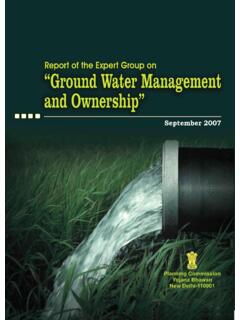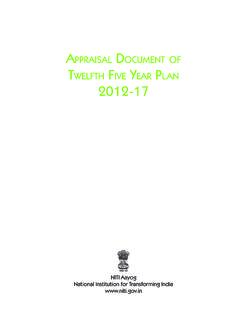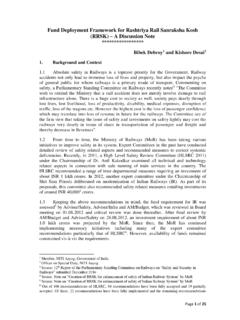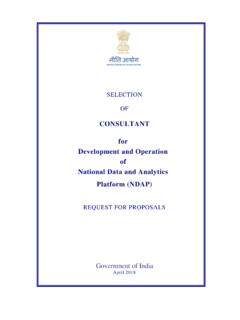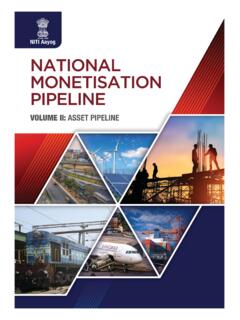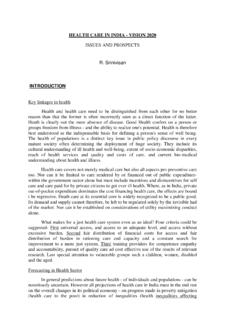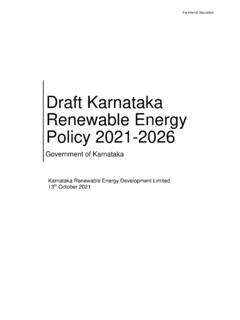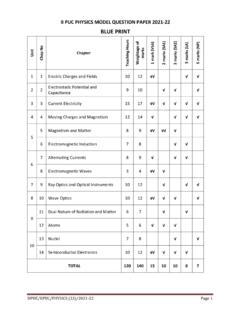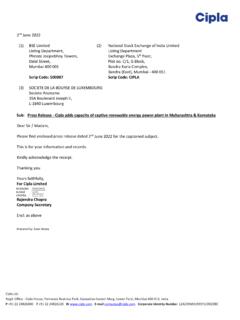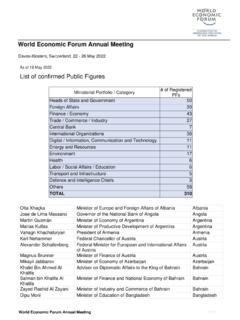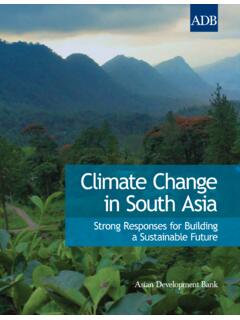Transcription of Sugar Report final 29th may - NITI Aayog
1 MARCH 2020 Page | 2 Page | 3 Foreword India is the largest consumer of Sugar in the world. The Sugar industry is amongst the most important agro-based industries in the country that impact livelihood of about 5 crore farmers and their family members and 5 lakh workers directly employed with the Sugar mills. There are more than 700 installed Sugar factories in the country with crushing capacity of about 340 lakh MT of Sugar and annual turnover of about Rs 80,000 crore. These numbers reflect the important role the Sugar industry plays in India s economy. However, with Sugar prices falling for a couple of years in a row while sugarcane prices moving up over the last few years, has put the industry in serious problems, including that of liquidity.
2 Despite series of measures announced by the Central Government to address these problems, the demand for more assistance has not subsided. Therefore, a need was felt by NITI Aayog to explore long-term solutions for the sugarcane and Sugar industry, so as to rationalise their dependence on state assistance and encourage farm diversification to reduce adverse impact of sugarcane cultivation on the water sector. Accordingly, a task force was constituted by NITI Aayog under my chairmanship, which included secretaries of D/o Food and Public Distribution (D/o F&PD), D/o Expenditure (DoE), D/o Agriculture Cooperation and Farmers Welfare (D/o AC&FW), Department of Commerce (DoC), Ministry of Petroleum and Natural Gas (M/o P&NG), Ministry of Environment, Forest and Climate Change (M/o EF&CC), Pr.
3 Secretary ( Sugar Industry and Cane Development, Department of Government of UP), Secretary (Co-operation, Textile and Marketing Department, Government of Maharashtra), Dr Bhanumurthy (Professor, NIPFP), Special Secretary (KIH, NITI Aayog ), Additional Secretary (Energy, NITI Aayog ) and Senior Adviser (Governance & Research, NITI Aayog ). The technical support to the task force was provided by the Department of Food and Public Distribution. The task force also interacted with representatives of the Indian Sugar Mills Association, National Federation of Cooperative Sugar Factories, Confederation of Indian Industries, sugarcane farmers from Maharashtra and Uttar Pradesh, etc.
4 , in its meetings. The task force broadly deliberated on (i) long-term solutions to the problems faced by sugarcane farmers and Sugar industry; (ii) measures for rationalising the Sugar economy; (iii) measures to make the Sugar industry less state dependent and align it with global markets; and (iv) encourage farm diversification so as to reduce adverse impact on the water sector. The task force has prepared this Report based on its deliberations that comprehensively cover the above-mentioned aspects and has suggested a policy roadmap both for the sugarcane sector and Sugar industry.
5 I would like to extend my gratitude to the members of the task force for their valuable inputs and providing domain expertise. I would like to particularly acknowledge the Page | 4 contributions of industry bodies, namely Indian Sugar Mills Association, All Indian Sugar Trade Association and National Federation of Cooperative Sugar Factories Ltd. for their inputs and providing industry perspective. In addition, I wish to place on record my appreciation of inputs provided by Shri Vashishth, Joint Secretary, Department of Food & Public Distribution, Shri Sandeep Poundrik, Joint Secretary, Ministry of Petroleum & Natural Gas as well as Shri Sanjay R.
6 Bhoosreddy, Pr. Secretary ( Sugar Industry & Cane Development Department of Government of Uttar Pradesh). I would also like to thank Government officials and farmer-cooperative representatives from Maharashtra and Uttar Pradesh for taking part in the deliberations of the task force. I wish to extend my deepest gratitude to Dr Yogesh Suri, Senior Adviser (G&R), NITI Aayog (convener of the task force), and his team for organising the task-force meetings and facilitating the preparation of this Report . I would also like to thank other officials of NITI Aayog : Shri Neeraj Singhal, Director (G Shri Desh Gaurav Sekhri, OSD; Dr Srivastava, Agriculture Economist; Shri Ankush Das, former Young Professional; Shri Satwik Mishra, Young Professional; and Dr Jaspal Singh, Consultant, for their inputs.)
7 The Report is expected to provide useful insights to policymakers to resolve the issues faced by sugarcane farmers and Sugar industry. The task force is hopeful that its suggestions and recommendations will be useful in finding resolution of the recurring problems of the sector on sustainable basis and keep balance between interests of various stakeholders. New Delhi March 30, 2020 Ramesh Chand, Member (Agriculture), NITI Aayog , Chairman of the Task Force Page | 5 List of Abbreviations Abbreviation Meaning A2 + FL Actual paid-out expenses incurred by farmers and imputed value of unpaid family labour AAY Antodaya Anna Yojana BIS Bureau of India Standards CACP Commission for Agricultural Costs and Prices CCEA Cabinet Committee on Economic Affairs CO2eq Carbon Dioxide equivalent CPCB Central Pollution Control Board DAC&FW Department of Agriculture Cooperation and Farmers Welfare DBT Direct Benefit Transfer DFPD Department of Food and Public Distribution EAC-PM Economic Advisory Council
8 To Prime Minister EBP Ethanol Blended Petrol FCI Food Corporation of India FFM Flex Fuel Motorcycles FFV Flex Fuel Vehicles FRP Fair and Remunerative Price GST Goods and Services Tax I (D&R) Act, 1951 Industries (Development and Regulation) Act, 1951 ISMA Indian Sugar Mills Association LMT Lakh Metric Tonne MIEQ Minimum Indicative Export Quota MoP&NG Ministry of Petroleum and Natural Gas MSP Minimum Support Price MSP of Sugar Minimum Selling Price of Sugar MT Metric Tonne NITI National Institution for Transforming India OMC Oil Marketing Company PDS Public Distribution System PSF Price Stabilisation Fund PSU Public Sector Undertaking RoR Rate of Return RSF Revenue Sharing Formula SAP State Advised Price SDF Sugar Development Fund SEFASU Scheme for Extending Financial Assistance to Sugar Undertakings
9 SMP Statutory Minimum Price SS Sugar Season UP Uttar Pradesh WTO World Trade Organisation ZLD Zero Liquid Discharge Page | 6 Report of the Task Force on Sugarcane and Sugar Industry Table of Contents List of Chapters Ch. No. Particulars Page No. Foreword by Prof. Ramesh Chand, Member (Agriculture), NITI Aayog 3 List of Abbreviations 5 Executive Summary 10 I Constitution of the Task Force 17 II Overview and Background 19 III Reforms in the Sugarcane and Sugar Industry 34 IV Ethanol Blending 37 V Saving Water by Shifting Area under Sugarcane Cultivation to Other Crops 44 VI Observations of the Task Force 52 VII Recommendations of the Task Force 57 Annexures 64 Page | 7 List of Tables Sl.
10 No. Particulars Page No. 1 Production of sugarcane and Sugar in the world (2015 16) 19 2 State-wise area under sugarcane cultivation (000 hectares) 20 3 State-wise production of sugarcane (000 tonnes) 21 4 State-wise yield of sugarcane (kgs/ha) 21 5 Sugar balance sheet for the last 5 seasons 24 6 SAP provided for sugarcane in different states of India (in /qtl) 26 7 Cost of production of sugarcane in comparison to FRP/ SAP (in /qtl) 27 8 Irrigation water requirement for and water productivity on sugarcane 30 9 Arrears at the end of January/ February/ March during last 5 Sugar seasons 31 10 Past Sugar committees 34 11 Rangarajan committee recommendations and status 35 12 Details of ethanol supplied and blending percentages 38 13 Differential pricing mechanism for ethanol 38 14 Allocation tenders of ethanol 39 15 Ethanol blending targets 39 16 Growth rate of area production and yield of sugarcane in India 45 17 Decomposition of change in sugarcane production 45 Page | 8 List of Figures Sl.
